Physical Address
304 North Cardinal St.
Dorchester Center, MA 02124
Mechanism of injury, low versus high velocity.
Complete PCL rupture usually associated with other ligament injuries.
Isolated PCL rupture represents serious injury, chance of functional deterioration, arthritis over time.
Indications for chronic isolated complete PCL rupture: pain and instability with athletics or other activities, swelling, ≥10 mm of increased posterior tibial translation (90 degrees of flexion).
Results of PCL reconstruction in chronic knees less favorable as arthritic symptoms persist.
Complete ruptures to the posterior cruciate ligament (PCL) account for approximately 2% to 3% of all knee ligament injuries in the general population. However, the reported incidence of PCL ruptures ranges between 1% and 44% of all acute knee ligament injuries. These injuries are classified as either low-velocity, such as those that occur from contact with another player in sports, or high-velocity, such as a dashboard injury in a motor vehicle accident. The mechanism of PCL rupture in athletes is usually a fall on the flexed knee with a plantar-flexed foot or hyperflexion of the knee. High-velocity injuries frequently involve dislocations with multiple ligament ruptures that require immediate medical attention. Traffic-related injuries appear to produce greater posterior tibial displacement values on stress radiography than sports-related injuries. In this chapter, the different types of PCL reconstructive techniques are described in detail to allow the surgeon to select the procedure most suited for the specific knee injury. In addition, the initial diagnosis and management of acute PCL ruptures is addressed in the “Preoperative Planning” section.
The proper management of complete ruptures to the PCL requires thorough knowledge of anatomy, diagnosis, surgical reconstruction, and rehabilitation concepts. Some aspects of the treatment of complete isolated PCL ruptures are controversial owing to the surgical limitations in completely restoring knee stability and the unclear natural history regarding long-term symptoms, functional limitations, and risk of joint arthritis. Although some studies (that included large percentages of patients with partial PCL deficiency) reported that patients did well when treated conservatively, other investigations described noteworthy symptoms and functional limitations after the injury. Many knees with complete PCL ruptures develop articular cartilage deterioration over time that usually occurs on the medial femoral condyle and patellofemoral surfaces owing to increased joint pressures and altered tibiofemoral and patellofemoral kinematics. * Posterior tibial subluxation with activities after PCL rupture has a deleterious effect to the knee similar to that of a medial meniscectomy because there is loss of medial meniscus function and increased joint contact stress. There is less of a deleterious effect on the lateral tibiofemoral compartment because the lateral meniscus retains load-bearing function. Posterior tibial subluxation with weight-bearing activities results in a loss of normal joint kinematics and in coupled external tibial rotation with joint loading. Accordingly, a PCL rupture would be expected to have a more deleterious effect in a varus-angulated knee with associated loss of the medial meniscus and, in particular, larger-sized athletes who desire to return to strenuous athletics. All of these factors alone or together result in substantial medial tibiofemoral loads and risk of joint deterioration.
* References .
The indications for surgical reconstruction in knees with a chronic isolated complete PCL rupture are pain and instability with athletics or other activities, swelling, and 10 mm or more of increased posterior tibial translation at 90 degrees of flexion ( Fig. 16-1 ). PCL reconstruction is most frequently performed in dislocated knees with gross instability owing to other ligament injuries to the anterior cruciate ligament (ACL), medial collateral ligament (MCL, see Chapter 19 ), or posterolateral structures (see Chapter 17 ). Indications for surgery in acute isolated PCL ruptures are discussed later in this chapter.
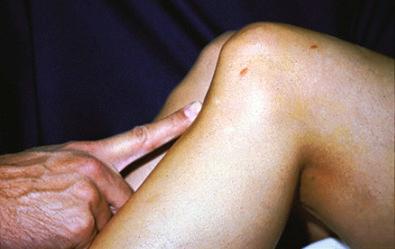
If symptomatic meniscal tears or early patellofemoral or tibiofemoral articular cartilage damage are present, early PCL reconstruction is recommended with the goal of decreasing joint deterioration over time. The results of PCL reconstruction in knees with chronic ruptures are not as favorable as those that undergo reconstruction for acute injuries. This is because patients with chronic ruptures frequently present with pain and swelling from joint deterioration that will often persist even though some benefit may be gained from improved knee stability from a reconstruction.
Acute partial and complete isolated PCL tears that will heal and provide partial function.
Advanced symptomatic patellofemoral or tibiofemoral arthrosis.
Varus-angulated knees with early medial tibiofemoral arthrosis; osteotomy required before PCL reconstruction.
Dislocated knee: vascular evaluation, protected range of knee motion, and return of muscle function before PCL reconstruction.
Loss of knee motion, quadriceps weakness, and hyperextension gait abnormalities require extensive rehabilitation and gait retraining before PCL reconstruction.
Contraindications to PCL reconstruction include acute partial and complete isolated tears that will heal and provide partial function with conservative treatment. Advanced symptomatic patellofemoral or tibiofemoral arthritis is a frequent contraindication. Unfortunately, many patients with chronic PCL deficiency present with severe associated joint arthritis. It is important to distinguish joint instability symptoms from symptomatic arthritis, in which case a ligament reconstruction would provide little to no benefit.
Patients with chronic PCL ruptures, varus angulation, and early medial tibiofemoral arthritis, or with increased lateral joint opening and associated posterolateral insufficiency, require high tibial osteotomy (HTO) before PCL reconstruction.
Dislocated knees require initial observation, vascular evaluation (ankle-brachial index), possible arteriography, early protected range of motion, and rehabilitation to restore muscle function before PCL reconstruction. We discourage the use of external fixators to initially stabilize the knee joint, because the use of these devices frequently results in arthrofibrosis and pin track infection and limits the ability to perform a ligament reconstruction. It is important to document with lateral radiographs that tibiofemoral reduction has been maintained and a residual posterior subluxation is not present.
In addition, patients with chronic PCL deficiency who have severe muscle atrophy, loss of knee motion, or hyperextension gait abnormalities require extensive rehabilitation and gait retraining before reconstruction (see Chapter 29 ).
A select group of morbidly obese patients sustain serious knee dislocations with minimal trauma. The lack of protective muscle function and the abnormal body weight places excessive tensile loads on ligament reconstructions, and a high rate of failure of a PCL reconstruction is expected. The preferred treatment for these patients is short-term plaster immobilization (and occasionally external fixation) to allow healing of soft tissues, followed by rehabilitation to return muscle function and knee motion. In only exceptional circumstances would operative repair (acute or chronic) be warranted in these patients, although consideration for surgical reconstruction is warranted after appropriate weight reduction.
PCL arises from a depression posterior to the intraarticular upper surface of the tibia, courses anteromedially behind ACL to lateral surface of medial femoral condyle.
Contains type I, type II, type IV mechanoreceptors.
91% of knees have at least one meniscofemoral ligament.
PCL complex anatomic structure composed of a continuum of fibers of different lengths and attachment characteristics.
PCL attachment extends from high in the notch (11:30 to 5 o'clock, right knee).
Anterior portion of PCL attachment follows articular cartilage within 2 to 3 mm of its edge.
Posterior third of PCL is 5 mm from the articular margin.
Proximal edge of PCL is straight or oval, with the attachment tapered in width along its posterior portion.
PCL femoral attachment described using rule of thirds to define the proximal-middle-distal thirds (deep to shallow in the femoral notch) and anterior-middle-posterior thirds.
Femoral attachment location strongly influences graft tension, ability of reconstruction to restore posterior stability.
PCL fibers function from proximal-to-distal in length changes with knee flexion.
The PCL attaches in a depression posterior to the intraarticular upper surface of the tibia and courses anteromedially behind the ACL to the lateral surface of the medial femoral condyle (see Chapter 2 ; Fig. 16-2 ). Illustrations by Anderson and colleagues show the anterior ( Fig. 16-3 ) and posterior ( Fig. 16-4 ) aspects of the PCL and its insertion characteristics. The PCL has an average length of 38 mm and an average width of 13 mm ( Table 16-1 ). The cross-sectional area of the PCL is variable and increases from its tibial to femoral insertions. It is approximately 50% larger than the ACL at its femoral origin and 20% larger than the ACL at its tibial insertion.
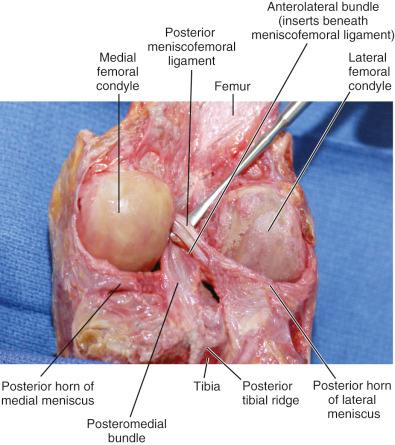
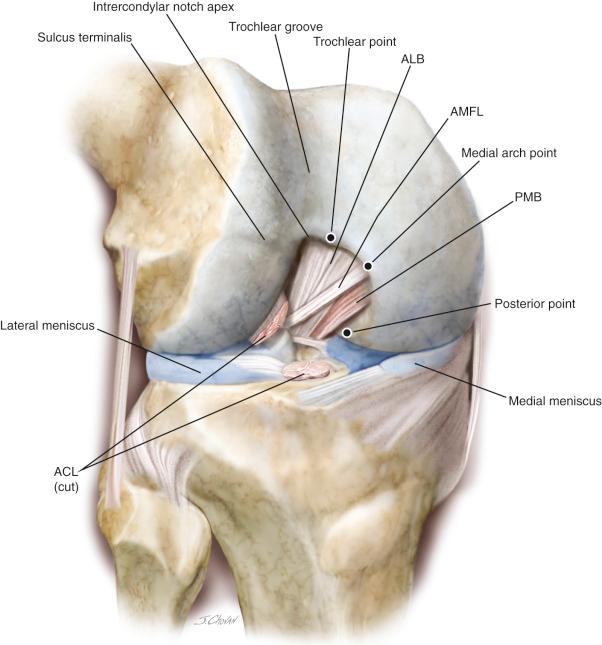
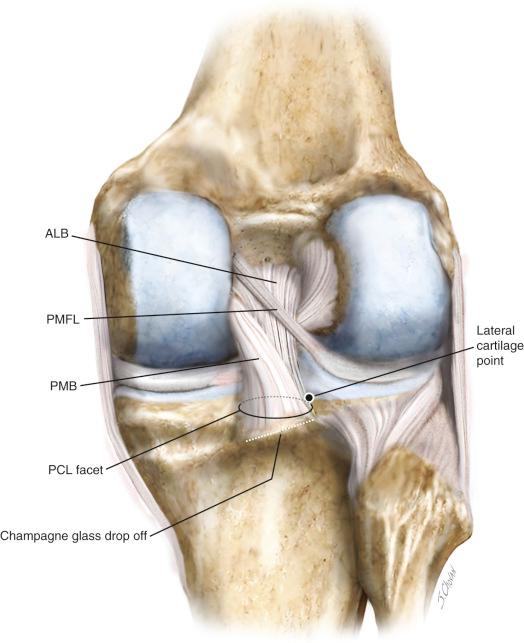
| Study | Methods | Specimens | PCL Footprint, Attachment/Insertion Sites | Anatomic Landmarks | Conclusions |
|---|---|---|---|---|---|
| Narvy et al (2014) | Systematic review of cadaveric and radiographic studies; 10 yr | Radiographic parameters: ALB center 40% and PLB 56% distance anterior surface femur. Cadaveric data : center of ALB 8 mm (27.5%) from cartilage edge, PLB 11.9 mm (42.5%) from anterior articular surface. | Blumensaat line, articular cartilage surface, medial intercondylar ridge | Review of 38 studies on PCL femoral footprint anatomy | |
| Hatsushika et al (2013) | ALB and PMB separated into ~20 small bundles (1 mm in diameter), attachment sites preserved; photographs, illustrations | n = 12, age unknown | Femoral attachment patterns similar; each small bundle ran in parallel towards tibial attachment in extension, crossed over each other in flexion. Tibial attachments showed two patterns: parabolic and transverse. | NA | First study to describe two patterns of ALB and PMB attachments in the tibia |
| Van Hoof et al (2013) | 3-D model from CT images. Concepts of best-fit cylinder and central axis given; illustrations | n = 9, 66-97 years | Mean footprint surface area: tibia 189.1 mm 2 , femoral 293.3 mm 2 . Mean diameter of best-fit cylinder, 10.5 mm. Mean coverage best-fit cylinder on tibial footprint 76.5%, femoral footprint 46.5%. | NA | Study confirmed large difference between tibial and femoral footprints. Best-fit 10-mm tunnel covers only 50% of femoral footprint; single-bundle PCL not able to be considered anatomic on femoral side. |
| Westermann et al (2013) | 3-D model from CT images; photographs, illustrations | n = 7, age unknown | Femoral footprint: center is 38% of the entire medial femoral condyle from anterior to posterior, parallel to Blumensaat's line on perfect lateral view and 25% of the condyle height from the notch roof on a perfect notch view. | NA | Provides standards of measurement for future studies that use advanced imaging for entire PCL insertion. Not applicable for location ALB or PMB. |
| Johannsen et al (2013) | AP and lateral x-rays, attachment centers labeled with radiopaque spheres, attachment areas labeled with barium sulfate; illustrations | n = 20, 21-59 years | Lateral view: ALB center located 17.4 mm posteroproximal, PMB center located 23.9 mm posteroproximal to anterior cortex line of femoral condyles. ALB tibial center located 8.4 mm, PMB center located 2.5 mm superior, PCL center 5.5 mm superior to “champagne glass drop-off” of posteroproximal tibia. | Lateral view: Blumensaat line and anterior cortex line, champagne glass drop-off of posteroproximal tibia | Most important findings on lateral views. Femur: measurements to Blumensaat line and anterior cortex line. Tibia: PCL attachment center measurement to champagne glass drop-off. Size scaling percentages not incorporated in measurements. Radiographic landmarks differ from cartilage-based arthroscopic landmarks. |
| Anderson et al (2012) | Electromagnetic tracking system used to outline structures, distances measured between center of fiber bundles and anatomic landmarks; photographs, illustrations, arthroscopic views | n = 20, 21-49 years | Femoral attachment: mean area PCL 192 mm 2 , ALB 112 mm 2 , PMB 60 mm 2 , anterior MFL 35 mm 2 , posterior MFL 31 mm 2 . Tibial attachment: mean area PCL, 219 mm 2 , PCL facet 291 mm 2 , ALB 88 mm 2 , PMB 105 mm 2 . | Tibia: lateral plateau articular cartilage, medial meniscus attachment, osseous ridge separating anterolateral and posteromedial bundles. | Used two femoral tunnels, one tibial tunnel. Center of femoral AL tunnel should be triangulated on basis of the trochlear point, the medial arch point, and the medial bifurcate prominence. Distal edge should be placed adjacent to articular cartilage. Femoral PM tunnel should be placed equal distance from the posterior point and medial arch point and just distal to the medial intercondylar ridge (center a mean 8.6 mm proximal to articular cartilage margin). Center of tibial tunnel should be just anterosuperior to bundle ridge, on the medial side of the PCL facet, 9.8 mm from lateral cartilage point and 5 mm from medial groove. |
| Osti et al (2012) | High-resolution digital images, two grid systems (16 rectangular zones), AP and lateral x-rays; photographs | n = 15, 82 ± 8 years | PCL tibial footprint mediolateral 10.37 mm, superoinferior 9.58 mm. ALB length 31.79 mm, femoral footprint mediolateral 7.85 mm, anteroposterior 8.51 mm, superoinferior 8.56 mm. PMB length 32.42 mm, femoral footprint mediolateral 6.84 mm, anteroposterior 8.82 mm, superoinferior 8.83 mm. | Cartilage borders, intercondylar roof, medial femoral condyle used in two measurement grid systems. | Provides femoral measurement grid system for arthroscopic views and x-ray images. |
| Greiner et al (2011) | CT, insertions marked with plastic markers; photographs, CT images, illustrations | n = 10, 60-85 years | Femoral insertion mean surface area 232 mm 2 . Tibial insertion trapezoidal shape, mean surface area 154.8 mm 2 . | Mean distance center of femoral insertion to roof of notch 8.9 mm; to anterior articular cartilage surface 18.7 mm. Tibial insertion centered 9.1 mm from posterior border of tibia on retrospinal surface, 1.6 mm inferior to plane of articular cartilage. | Study documented native femoral and tibial attachments relative to CT-specific landmarks. |
| Lee et al (2010) | Four corners of tibial footprint marked with drill tip, screws inserted at each corner and at 1-cm intervals in posterior cortex aligned with the tibial tunnel. AP and lateral x-rays, CT; photographs, x-ray, and CT images | n = 10, 34-61 years | Mean tibial insertion from joint line on AP x-ray 5.9 ± 1.1 mm to proximal aspect of PCL, 17.4 ± 2.4 mm to the distal aspect of PCL. Mean tibial insertion from joint line on lateral x-ray, 2.2 ± 1.2 mm to proximal aspect of PCL and 12.3 ± 1.5 mm to distal aspect of PCL. |
PCL facet (fossa) consistent radiographic landmark for pin placement. PCL insertion was in posterior 48% of the area of the posterior intercondylar fossa, to the posterior cortex. | Mean tibial insertion of PCL from joint line was located higher on lateral x-ray than on AP x-ray. Identified posterior intercondylar fossa and posterior cortex that align with the tibial tunnel. |
| Jeong et al (2010) | 3-D CT-based knee joint model. Femoral attachment divided into four sectors, tibial attachment divided into six sections; 24 virtual PCL bundles; illustrations | n = 10 living subjects, healthy knees, scanned 0, 90, 135 degrees | At 0 and 90 degrees, bundle with least amount of length change was PMB inserting into most posterior femoral sector and most distal tibial sector. Change was not different compared with other bundles with tibial points attached to same femoral sector. | No isometric points in any virtual PCL bundle. Avoid high flexion during postoperative rehabilitation. | |
| Tajima et al (2009) | Macroscopic observation, 3-D laser photography; photographs, illustrations | n = 21, 42-93 years | Mean area PCL tibial attachment 243.9 mm 2 , AL insertion 93 mm 2 , PM insertion 150.8 mm 2 . | Posterior intercondylar fossa: ALB attached to superolateral aspect (slope), PMB attached to inferomedial aspect (slope). Change of >10 degrees observed between AL and PM slopes. | Tibial insertion complex, shapes, and positions of insertion sites of AL and PM consistently located in different planes on fossa. |
| Lopes et al (2008) | Macroscopic observation, 3-D laser photographs; photographs, illustrations | n = 20, 57-93 years | Mean area PCL femoral footprint 209 mm 2 , mean ALB 118 mm 2 , PMB 90 mm 2 . AL center 7 ± 2 mm (10:20 o'clock), PM center 10 ± 3 mm (8:30 o'clock) from the articular cartilage. | Femoral footprint: osseous prominence proximal frequently seen (medial intercondylar ridge). Small osseous prominence between ALB and PMB in some knees. | Femoral footprint has medial intercondylar ridge usually present. |
| Moorman et al (2008) | Observation, histology, lateral x-rays; photographs, x-rays | n = 14, age unknown | Mean PCL tibial insertion AP dimension 15.6 ± 1.1 mm. Center tibial insertion mean 7 mm anterior to the posterior cortex. Majority of fibers insert on posterior half of PCL facet. | PCL facet | Tunnel placement at the center of the PCL can be measured along the PCL facet as seen in a true lateral x-ray. |
| Edwards et al (2007) | Observation, high-resolution digital photos; photographs, illustrations | n = 39, 60-80 years | Tibial attachment occupied posterior intercondylar fossa. Parallel femoral long axis: AL 9 to 12 o'clock (center, 10:20); 7 ± 2 mm (range, 4-12 mm) from cartilage edge. PMB 7:30 to 10:30 o'clock (center, 8:30), 10 ± 3 mm (range, 6-19 mm) from cartilage edge. | Posterior intercondylar fossa, Blumensaat's line, articular cartilage outlines | Tibial attachments consistent pattern in posterior intercondylar fossa. Femoral attachment required more than one measuring system. |
Free nerve endings and mechanoreceptors have been identified in the femoral and tibial attachment sites and on the surface of the PCL. The mechanoreceptors resemble Golgi tendon organs and are believed to have a proprioceptive function in the knee.
In a histologic study of the PCL in cadaveric knees, Katonis and coworkers reported a neural innervation similar to that of the ACL. Specifically, the PCL contains type I or Ruffini's corpuscles that have a slow threshold to pressure changes, type II (Vater-Pacini) corpuscles that are more rapid acting, and type IV (free nerve endings) corpuscles for pain reception. The mechanoreceptors are located at each ligament bony attachment and on the surface of the PCL.
The meniscofemoral ligaments are in close proximity to the PCL. They arise from the posterior horn of the lateral meniscus and insert near the PCL insertion site on the lateral aspect of the medial femoral condyle. The anterior meniscofemoral ligament (ligament of Humphrey) courses anterior to the PCL, and the posterior meniscofemoral ligament (ligament of Wrisberg) runs obliquely behind the PCL. Frequently, the anterior meniscofemoral ligament interdigitates with the PCL fiber attachments on the medial femoral condyle ( Fig. 16-5 ). At least one of the meniscofemoral ligaments is present in 91% of knees, and both ligaments may be found in 50% of knees in young individuals. The biomechanical function of the meniscofemoral ligaments is discussed in detail in Chapter 23 .
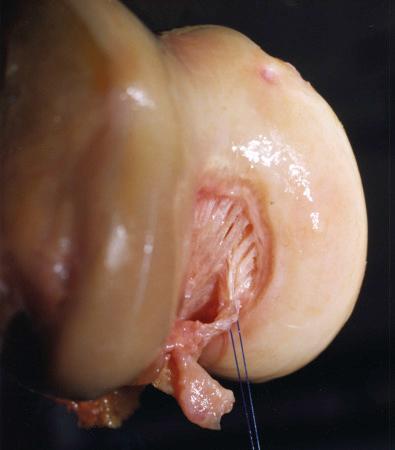
The traditional division of the PCL into a separate anterolateral bundle (ALB) and posteromedial bundle (PMB) oversimplifies PCL fiber function. The PCL is a complex anatomic structure composed of a continuum of fibers of different lengths and attachment characteristics. The length-tension behaviors of the fibers that resist posterior tibial translation (with knee flexion) are controlled primarily by femoral attachment regions. The distal fibers lengthen with increasing knee flexion and the proximal fibers shorten with knee flexion. A detailed description of the length-tension behavior of the PCL appears in Chapter 15 .
The anatomy of the PCL femoral attachment site has been studied extensively (see Table 16-1 ). Variation exists between knees in the shape of this attachment, from the common elliptical shape to a more rounded and thicker shape ( Fig. 16-6 ). Different measurement systems have been proposed to describe the femoral attachment site. The most common method uses a clock reference position ( Fig. 16-7 ), with measurement lines perpendicular to the articular cartilage edge and measurement lines parallel to the femoral shaft ( Fig. 16-8 ). The clock method is a general guide and not highly accurate; therefore the entire PCL footprint and relationships to other structures described should be viewed.
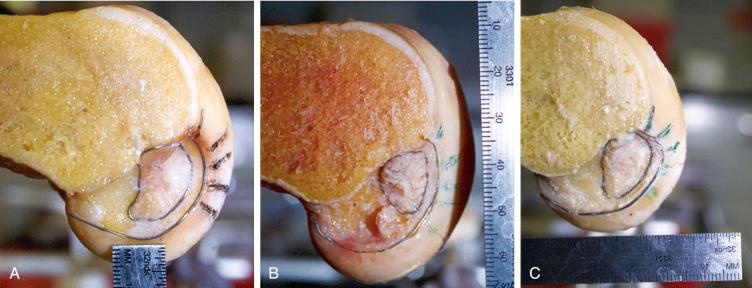
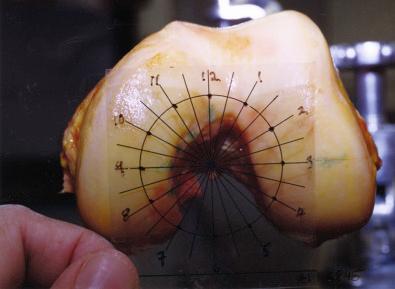
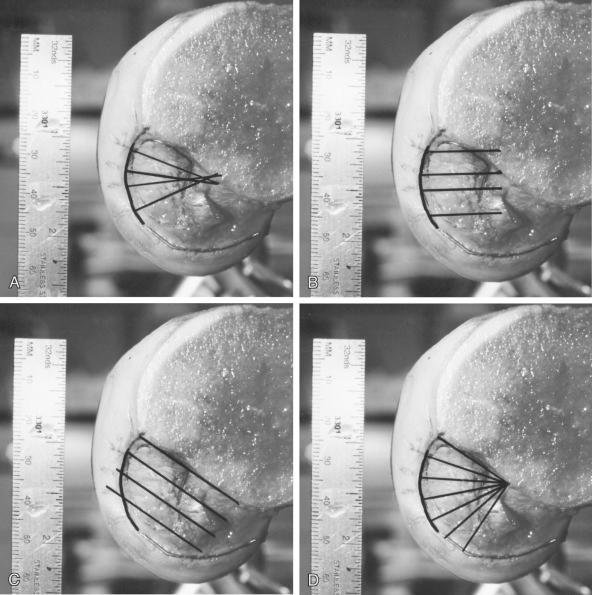
In general, the PCL attachment extends from high in the notch (11:30 to 5 o'clock position on a right knee) along the medial femoral condyle notch. The anterior portion of the PCL attachment follows the articular cartilage within 2 to 3 mm of its edge and gradually recedes deeper within the notch until, at the 5 o'clock position, the posterior third is 5 mm from the articular margin. Therefore the distal boundary of the PCL femoral attachment does not parallel the articular margin as reported by others but is farthest away from the cartilage margin posteriorly.
The distal and proximal measurements for the PCL femoral attachment are shown in Table 16-2 and measurements vary from one study to another depending on the method selected. The proximal edge of the PCL is usually straight or partially oval, with the attachment tapered in width along its posterior portion.
| Measurement | Distal (mm) | Proximal (mm) | Thickness (mm) |
|---|---|---|---|
| Perpendicular to the Cartilage | |||
| 12 o'clock | 2.54 ± 1.0 | 12.92 ± 2.8 | 10.38 ± 2.8 |
| 1 o'clock | 2.38 ± 0.7 | 14.33 ± 2.2 | 11.96 ± 2.0 |
| 2 o'clock | 2.38 ± 0.5 | 14.79 ± 1.8 | 12.42 ± 1.7 |
| 3 o'clock | 2.54 ± 0.5 | 14.83 ± 2.0 | 12.50 ± 1.7 |
| 4 o'clock | 2.71 ± 0.7 | 13.92 ± 2.4 | 11.21 ± 2.2 |
| Parallel to the Femoral Shaft | |||
| 12 o'clock | 2.54 ± 1.0 | 12.75 ± 2.8 | 10.25 ± 2.8 |
| 1 o'clock | 2.38 ± 0.7 | 13.75 ± 2.8 | 11.38 ± 2.8 |
| 2 o'clock | 2.46 ± 0.7 | 14.63 ± 2.0 | 12.17 ± 1.9 |
| 3 o'clock | 2.63 ± 0.8 | 13.42 ± 2.2 | 10.83 ± 2.2 |
| 4 o'clock | 3.78 ± 1.0 | 11.06 ± 2.6 | 7.39 ± 2.9 |
The PCL attachment measurements parallel to the intercondylar roof are shown in Table 16-3 . The length of the radial measurement lines extending from the intercondylar roof are shown in Table 16-4 . This method provides a means to measure the middle and lower portions of the PCL and provides information on the distance from the lowest cartilage margin to the most posterior portion of the PCL attachment.
| Line Location (mm) | Distal (mm) | Proximal (mm) | Thickness (mm) |
|---|---|---|---|
| 0 | 3.50 ± 1.7 | 13.82 ± 2.8 | 10.36 ± 3.3 |
| 5 | 2.50 ± 0.7 | 16.96 ± 2.5 | 14.54 ± 2.0 |
| 10 | 3.67 ± 1.3 | 15.21 ± 3.7 | 11.46 ± 3.7 |
| 15 | 4.25 ± 1.1 | 13.25 ± 3.9 | 9.00 ± 4.9 |
| Distal (mm) | Proximal (mm) | Thickness (mm) | |
|---|---|---|---|
| 0 | 3.17 ± 1.9 | 12.92 ± 4.7 | 9.75 ± 4.2 |
| 1 | 2.33 ± 0.7 | 15.00 ± 2.5 | 12.67 ± 2.0 |
| 2 | 2.63 ± 0.7 | 14.96 ± 2.0 | 12.33 ± 1.8 |
| 3 | 2.54 ± 0.5 | 14.04 ± 1.7 | 11.50 ± 1.9 |
| 4 | 2.75 ± 0.9 | 12.88 ± 1.8 | 10.13 ± 1.9 |
| 5 | 3.08 ± 0.9 | 1.46 ± 2.1 | 8.38 ± 2.1 |
| 6 | 3.21 ± 1.1 |
The use of measurement lines perpendicular to the cartilage edge is preferred for describing the distal attachments of the PCL (see Fig. 16-8, A ). The disadvantage of this system is that the 12 o'clock and usually the 1 o'clock measurements cannot be made parallel to the femoral shaft but must be done perpendicular to the cartilage ( Fig. 16-9 ).
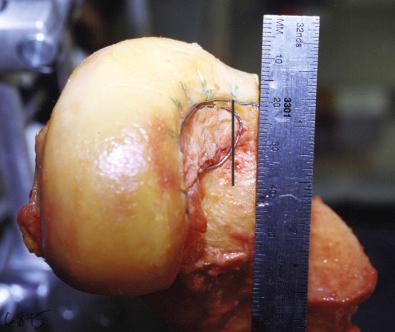
Therefore more than one measurement system is required to describe the anterior, middle, and posterior portions of the PCL femoral origin. Location of the center of the clock face midway in the notch is difficult but critical for identification of the landmarks required to map the PCL femoral attachment. This location should be identified with the knee at 90 degrees of flexion. Ideally, sagittal, anteroposterior (AP), and notch descriptions are required to anatomically represent the entire PCL attachment.
A clear understanding of the anatomy of the native PCL is critical to determine what portion of the ligament will be reconstructed. The terms “high,” “low,” “shallow,” and “deep” are only general descriptors. Because there may be considerable confusion regarding femoral graft tunnel placement during PCL reconstruction, the PCL femoral attachment is described using the rule of thirds ( Fig. 16-10 ) to define the proximal-middle-distal thirds (deep to shallow in the femoral notch), and anterior-middle-posterior thirds (high to low), with a small posterior oblique portion in the sagittal plane. This provides a grid for the identification of the tunnel locations for the graft strands and is preferred by the senior author (F.R.N.).
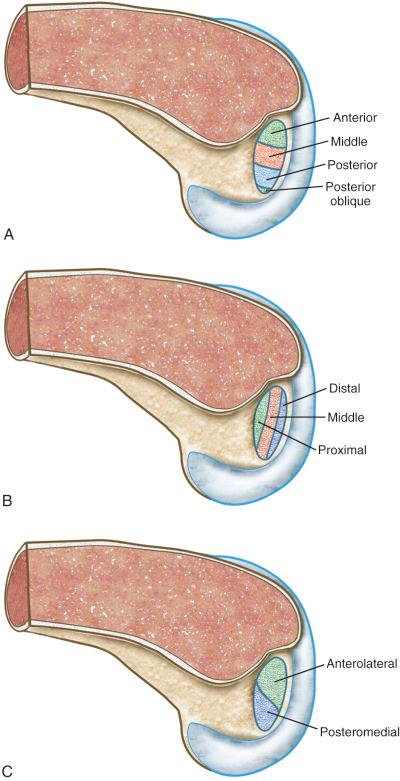
It is well appreciated that the PCL graft femoral attachment location strongly influences graft tension and the ability of the reconstruction to restore posterior stability. Investigations by Grood and associates and Sidles and colleagues demonstrated that the femoral attachment location determines the graft tibiofemoral separation distance with knee flexion-extension, much more so than the tibial attachment location. The proximal-distal femoral location of a graft has a greater effect on the attachment separation distance than the AP femoral location, which is the basis for the rule of thirds (see Fig. 16-10, B ). A graft placed in the distal and middle thirds elongates with knee flexion, whereas a graft placed in the proximal third elongates with knee extension. These concepts are used to select PCL graft attachment locations and tensioning described in the “Operative Techniques” section.
Anderson and colleagues described, in 20 unpaired cadaveric knees, the PCL femoral and tibial attachments of the ALB and PMB to provide the surgeon with landmarks for the placement of PCL grafts. The femoral PCL attachment is illustrated in Figure 16-3 and the arthroscopic viewpoint is illustrated in Figure 16-11 . The centers of the ALB and the PMB were a mean of 7.9 mm and 8.6 mm, respectively, from the articular cartilage edge, which is in close agreement with the data previously presented (see Table 16-1 ). It is understood that the variability among studies of a few millimeters reflect differences in both measurement techniques and cadaveric specimens. Even so, the data of these collective studies allow a reasonable definition of the PCL attachment sites at surgery. The AL portion extends distally to within approximately 2 mm of the femoral articular cartilage edge or margin, and the PM portion extends distally 4 to 6 mm from the femoral articular cartilage edge. This analysis allows for a more distal femoral placement of PCL grafts than has been historically recommended, as will be discussed.
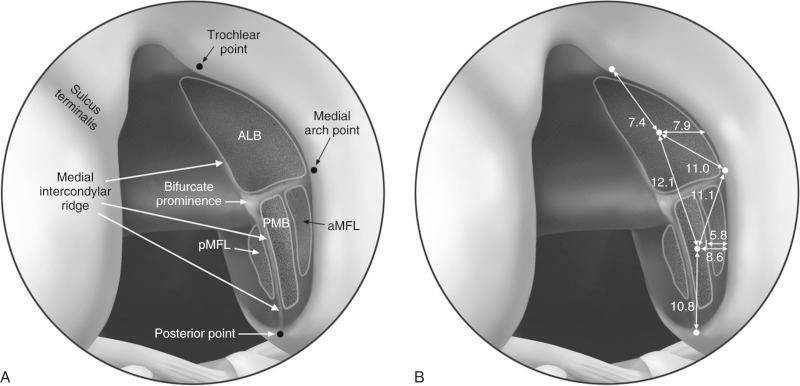
An illustration of the posterior PCL tibial attachment is shown in Figure 16-4 . The landmarks for the tibial attachment of the PCL are illustrated in Figure 16-12 . The shiny fibers of the medial meniscus attachment are easily viewed at surgery. The posterior capsule attachment at the posterior tibial ridge is illustrated as an opening to show the proximity of the popliteus muscle. This posterior capsular attachment is always preserved and not violated at surgery.
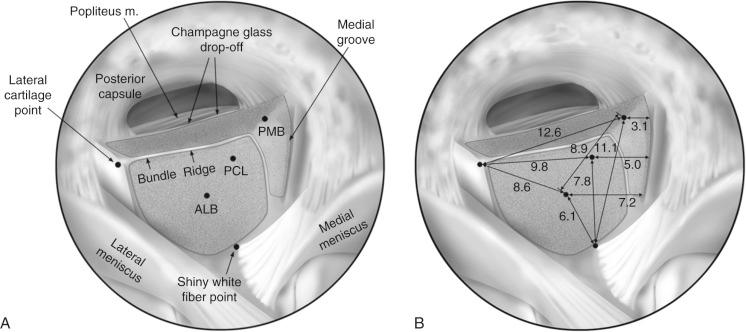
Vascular supply mostly provided by middle genicular artery.
Popliteal artery originates at adductor hiatus, passes through popliteal fossa, and divides into anterior and posterior tibial arteries at the distal aspect of the popliteus muscle.
Four major arteries at level of knee joint: medial and lateral sural arteries, a cutaneous branch that travels with the small saphenous vein to supply superficial tissues, middle genicular artery.
Medial and lateral inferior genicular arteries given off just distal to knee joint.
Normal vascular pattern 88% of knees, 5%-7% anatomic variation, anterior tibial artery passes anterior and proximal to popliteus muscle.
Popliteal artery: anatomic variability possible, manifests as popliteal artery entrapment syndrome.
Embryologic development explains abnormal vascular patterns.
The vascular supply to the cruciate ligaments is provided mostly by the middle genicular artery, which is a branch of the popliteal artery that penetrates the posterior capsule of the knee. The PCL is covered with a well-vascularized synovial sleeve that contributes to its blood supply. The distal portion of the PCL also receives some vascular supply from capsular vessels originating from the inferior genicular arteries and the popliteal artery.
Detailed knowledge of posteromedial knee anatomy, especially the vascular structures, is required to avoid complications when using a posteromedial approach to a tibial inlay PCL reconstruction (see Chapter 2 ). The popliteal artery originates at the adductor hiatus and passes through the popliteal fossa. Before passing deep to the fibrous arch over the soleus muscle, it divides into the anterior and posterior tibial arteries at the distal aspect of the popliteus muscle.
Proximal to the knee joint, several muscular branches arise and supply the adductor magnus and hamstring muscles. At the level of the supracondylar ridge, the superomedial and superolateral genicular arteries are present.
At the level of the knee joint, four major arteries are distributed: the medial and lateral sural arteries, a cutaneous branch that travels with the small saphenous vein to supply superficial tissues, and the middle genicular artery. Finally, the medial and lateral inferior genicular arteries are present just distal to the knee joint.
Two branches deserve particular attention. The medial inferior genicular artery arises from the medial aspect of the distal portion of the popliteal artery and runs medially, deep to the medial head of the gastrocnemius, and approximately 2 to 3 mm from the superior surface of the popliteus muscle. It continues around the medial aspect of the proximal tibia, deep to the superficial medial collateral ligament (SMCL). The middle genicular artery arises at the level of the femoral condyles proximal to the joint line and passes anteriorly to pierce the oblique popliteal ligament (OPL) and posterior joint capsule and supply the cruciate ligaments.
This “normal” vascular pattern has been reported to occur in approximately 88% of cases. In approximately 5% to 7% of cases, the popliteal artery will divide at least 2 cm or more proximal to the popliteus muscle. In slightly less than half of these cases, with a high division of the popliteal artery, the anterior tibial artery passes anterior, not posterior, to the popliteus muscle belly. The number of variations of the anterior tibial artery according to Mauro and coworkers is illustrated in Figure 16-13 . Therefore with a tibial inlay approach, the dissection is always proximal to the popliteus muscle with a meticulous technique, because the anterior tibial artery is at risk for transection in approximately 3% to 4% of knees.
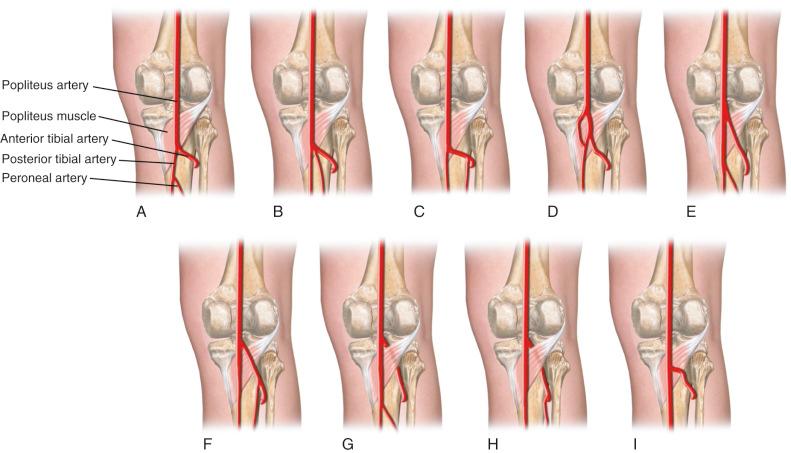
An unusual variation in the vascular pattern involves the popliteal artery passing medial and then beneath the medial head of the gastrocnemius. Various subtypes of this abnormal pattern have been described. An abnormal vascular pattern may manifest clinically as the popliteal artery entrapment syndrome, which is characterized by vascular claudication symptoms. Arterial insufficiency occurs most commonly with entrapment of the artery deep to the medial gastrocnemius muscle, but can also occur when the artery is entrapped deep to the popliteus muscle (persistence of ventral component of artery) or deep to an abnormal accessory head of the gastrocnemius. A history of pain in the lower extremity with activity and disappearance with rest, particularly in a young patient, should alert the surgeon to the possibility that an abnormal vascular pattern may exist. Further evaluation with angiography may be warranted.
Embryologic development helps to explain these abnormal vascular patterns. In the embryo, the lower extremity blood supply is derived from the sciatic or axial artery (a branch of the internal iliac artery) as well as the femoral artery (a branch of the external iliac artery). The proximal sciatic artery regresses, whereas the middle and distal sciatic artery persist to form the definitive popliteal and peroneal arteries.
The anterior tibial artery arises as a branch of the popliteal artery and initially courses anterior to the popliteus muscle. In humans, the early anterior tibial artery is replaced with the superficial popliteal artery and passes posterior to the popliteus muscle, which then gives rise to the anterior tibial artery. Furthermore, during embryonic life, the medial head of the gastrocnemius migrates medially and cranially. It is with this migration that the popliteal artery can be caught and swept medially with the muscle.
Patellofemoral joint, extensor mechanism malalignment
Patellofemoral and tibiofemoral crepitus
Gait abnormalities
Abnormal knee motion limits, subluxations
Posterior drawer, 90 degrees of knee flexion
Pivot shift, Lachman
KT-2000, 20 degrees of knee flexion, 189 N of force (optional)
Reverse pivot shift
Medial tibiofemoral joint opening 0, 30 degrees of knee flexion
Lateral tibiofemoral joint opening 0, 30 degrees of knee flexion
Tibiofemoral rotation dial test, 30 and 90 degrees of knee flexion
Anteroposterior
Lateral, 30 degrees of knee flexion
Posteroanterior, weight bearing, 45 degrees of knee flexion
Patellofemoral axial
Posterior stress, 90 degrees of flexion, 89 N posterior force on tibia
Medial or lateral stress, neutral tibial rotation, tibia unconstrained, 89 N varus force
Double-stance to measure mechanical axis and weight bearing line
Sports Activity and Function Form
Occupational Rating Form
Symptom Rating Form
A comprehensive examination of the knee joint is required to detect all abnormalities. This includes assessment of, first, the patellofemoral joint and patellar tendon-tibial tubercle alignment (Q angle), which may be increased owing to increased external tibial rotation when a posterolateral ligament injury accompanies the PCL rupture. Second, patellofemoral and tibiofemoral crepitus, is indicative of articular cartilage damage. Third, gait abnormalities (excessive hyperextension or varus thrust) are assessed during walking and jogging. Finally, abnormal knee motion limits and subluxations are compared with those of the contralateral knee .
Experienced clinicians are aware that patients with chronic deficiency of the PCL and posterolateral structures may develop an abnormal gait pattern that is characterized by excessive knee hyperextension during the stance phase. Subjective complaints of knee instability and giving-way during routine daily activities, along with severe quadriceps atrophy, often accompany this gait abnormality. Gait analysis and retraining are required in patients who demonstrate abnormal knee hyperextension patterns before proceeding with any ligament reconstruction (see Chapter 29 ). The failure to do so may lead to failure of reconstructed ligaments if the abnormal gait pattern is resumed postoperatively.
The medial posterior tibiofemoral step-off on the posterior drawer test is performed at 90 degrees of flexion. The amount of posterior tibial translation will vary between knees with isolated PCL ruptures because of physiologic laxity or injury to the secondary posterolateral or medial soft tissue restraints. Posterior tibial translation progressively increases with injury to the secondary restraints. The importance of determining abnormal medial or lateral joint opening and increases in external-internal tibial rotation cannot be overemphasized, because the failure to correct these associated subluxations places PCL graft reconstructions under high in vivo forces postoperatively and risk of graft failure. The diagnostic tests and their interpretation are discussed in Chapter 15 .
The exact determination of the extent of a PCL tear (partial versus complete) can be difficult but is essential from a therapeutic standpoint. The clinical posterior drawer test can be highly subjective, with the forces applied too variable to allow accurate determination of the status of the PCL. Magnetic resonance imaging (MRI) is not always accurate in diagnosing partial PCL tears ( Fig. 16-14 ). Frequently, this test may indicate that the ligament is completely ruptured; however, ligament continuity may still exist with some portions functioning to limit posterior tibial subluxation to only a few millimeters. Patten and associates reported only a 67% sensitivity rate of the ability of MRI to distinguish complete from partial PCL tears by identifying focal areas of ligamentous discontinuity.
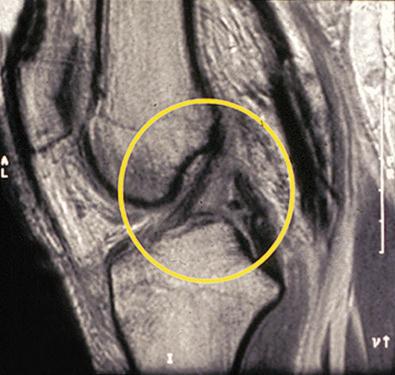
The quantitative measurement of posterior tibial subluxation in knees with PCL ruptures or reconstruction is therefore important. The knee arthrometer is the most frequently used device to measure posterior tibial translation after PCL injury and reconstruction. However, the knee arthrometer underestimates the true amount of posterior translation in PCL-deficient and reconstructed knees, often by several millimeters. Stress radiography is the most accurate and reproducible technique currently available. We recommend that PCL clinical investigations incorporate stress radiography to provide a more valid measure of posterior tibial translation ( Fig. 16-15 ). To correct for tibial rotation, which can produce errors in measurement, the radiograph should be as close to a pure lateral as possible, with the two femoral condyles superimposed on themselves. A horizontal line is placed across the medial tibial plateau and a perpendicular line determines the posterior position of each femoral condyle. A similar measurement is made for the most posterior position of the medial and lateral tibial plateau. The amount of tibial translation is the average of both of these measurements. An alternative technique is to measure the posterior extent of the Blumensaat line and the proximal aspect of the PCL tibial fossa, which avoids the error of tibial rotation.
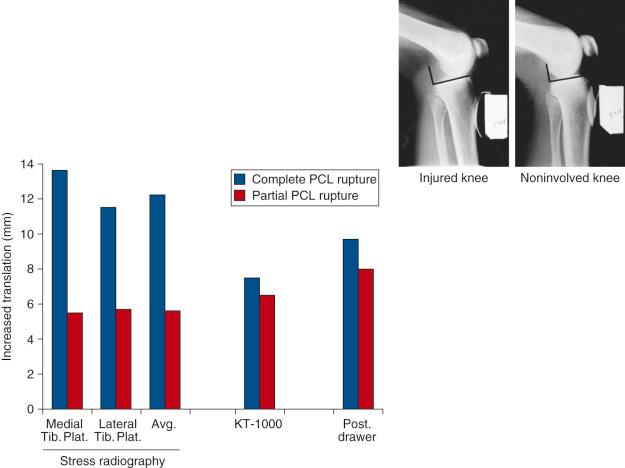
The integrity of the ACL is determined by Lachman and pivot shift testing. The result of the pivot shift test is recorded on a scale of 0 to III, with a grade of 0 indicating no pivot shift; grade I, a slip or glide; grade II, a jerk with gross subluxation or clunk; and grade III, gross subluxation with impingement of the posterior aspect of the lateral side of the tibial plateau against the femoral condyle. A KT-2000 arthrometer test may be done at 20 degrees of flexion (134-N force) to quantify total AP displacement.
Medial and lateral ligament insufficiency are determined by varus and valgus stress testing at 0 and 30 degrees of knee flexion. The surgeon estimates the amount of joint opening (in millimeters) between the initial closed contact position of each tibiofemoral compartment, performed in a constrained manner avoiding internal or external tibial rotation, and the maximal opened position. The result is recorded according to the increase in the tibiofemoral compartment of the affected knee compared with that of the opposite normal knee.
The tibiofemoral rotation dial test at 30 and 90 degrees is done to determine whether increases in external tibial rotation exist with posterior subluxation of the lateral tibial plateau (see Chapter 17 ).
The presence of a varus recurvatum in both the supine and standing positions is carefully assessed. The difference in results of these tests must be done between the injured and contralateral normal knee because of inherent physiologic looseness present in some individuals.
Radiographs taken during the initial examination include AP, lateral at 30 degrees of knee flexion, weight-bearing posteroanterior (PA) at 45 degrees of knee flexion, and patellofemoral axial views.
Posterior stress radiographs are done with an 89-N force applied to the proximal tibia. A lateral radiograph is taken of each knee at 90 degrees of flexion. The limb is placed in neutral rotation with the tibia unconstrained and the quadriceps relaxed. The difference in posterior tibial displacement between the reconstructed knee and the contralateral knee is recorded. More than 8 mm of increase in posterior tibial translation on stress testing indicates a complete PCL rupture and more than 12 mm of increase is indicative of probable injury to the posterolateral structures.
Medial or lateral stress radiographs may be required of both knees. The patient is seated (20 degrees of knee flexion) in neutral tibial rotation with the tibia unconstrained. Approximately 89 N of varus or valgus force is applied and a comparison is made of the millimeters of medial or lateral tibiofemoral compartment opening between knees.
Full standing radiographs of both lower extremities, from the femoral heads to the ankle joints, are done in knees in which varus lower extremity alignment is detected on clinical examination. The mechanical axis and weight-bearing line are measured to determine whether HTO is indicated before PCL reconstruction (see Chapter 26 ). If the varus malalignment is not corrected, there is a risk that either a PCL or ACL graft may fail owing to the varus thrusting forces and concurrent increased lateral joint opening producing high graft tension loads.
Patients complete questionnaires and are interviewed for the assessment of symptoms, functional limitations, sports and occupational activity levels, and patient perception of the overall knee condition according to the Cincinnati Knee Rating System (CKRS).
Reattach native PCL bony avulsion injuries, peel-off injuries directly at PCL attachment, predictable healing rates.
Select knees, augmentation with semitendinosus tendon may facilitate PCL repair, add postoperative protection.
Partial or acute isolated PCL tears
Immobilize 4 weeks in full knee extension brace or bivalved cylinder cast.
Lateral radiograph verifies no posterior tibial subluxation.
2 weeks: 0-90 degrees of motion maintaining anterior tibial translation load. Patient sleeps in brace, no unsupervised knee motion.
4 weeks: active quadriceps extension out of brace, 50% weight bearing, crutch support, maintain brace protection.
5-6 weeks: wean from the brace and crutch support, rehabilitation.
Acute PCL injuries with associated rupture to medial or posterolateral structures: delay reconstruction until neurovascular status and other injuries are resolved and major knee ligament surgery can be safely performed.
Associated posterolateral ruptures: acute anatomic repair required within 14 days before scarring occurs.
PCL graft reconstruction in select athletes before secondary restraints stretch out with subsequent reinjury, arthritis.
Acute disruption: delay reconstruction to resolve other injuries.
Posterolateral injuries: perform anatomic repair within 14 days if possible.
Displaced meniscus tear: repair as soon as possible, all-inside technique.
Dislocated knees: majority treated in staged approach, surgery delayed, knee protected to prevent posterior tibial subluxation.
MCL disruptions require cast 7 to 10 days that is then split into anterior and posterior shell to allow therapist-assisted range of motion.
Assess patient's symptoms, goals, athletic desires: may indicate PCL reconstruction required.
Varus malalignment: osteotomy before PCL reconstruction.
PCL plus medial or posterolateral ligament injury, complex instability pattern, usually surgical candidate.
Severe arthrosis: not expected to benefit from PCL reconstruction.
Nonoperative approach chronic PCL tears: warn that return to athletics carries uncertain prognosis, joint arthrosis may eventually ensue.
Consider bone scan, MRI cartilage sequences.
Initiate rehabilitation, patient's education, avoid high knee flexion activities.
Controversy exists in the treatment of isolated midsubstance complete PCL ruptures, primarily owing to the lack of a scientifically proven operative procedure that can predictably restore posterior stability and PCL function. In comparison, surgical procedures to reattach the native PCL in cases of bony avulsion injuries or peel-off injuries directly at the PCL attachment site have more predictable healing rates. In cases of PCL rupture directly at the attachment site, there is usually sufficient ligament substance for a direct repair. In select situations, an augmentation using the semitendinosus tendon may facilitate PCL repair. Augmentation of partial PCL tears is controversial and only indicated in high-grade tears. Posterior stress radiography plays an important role in determining whether an abnormal increase of 10 mm or more of posterior tibial translation exists, indicating loss of PCL function. Partial ligament tears are treated conservatively with an extension brace and posterior calf pad or bivalved cast to allow for potential PCL healing.
The treatment rationale for patients with acute PCL ruptures is shown in Figure 16-16 . The algorithm is divided into three major sections based on the PCL tear (partial, complete, or combined with other ligament ruptures). The 10-mm division is somewhat arbitrary. As discussed, stress radiography is helpful in determining the exact increase in posterior tibial translation. The rules to treat partial or acute isolated PCL tears are used when the injury is seen within the first two weeks; after this time, the program is not instituted. The program rules are as follows:
Immobilize for 4 weeks in a full knee extension brace or bivalved cylinder cast to maintain tibiofemoral reduction. Use quadriceps isometrics, electrical muscle stimulation, leg raises, and 25% weight bearing.
Obtain an AP and lateral radiograph to verify that no posterior tibial or lateral subluxation exists, which can occur in up to 50% of knees.
At 2 weeks, the therapist initiates 0 to 90 degrees of motion, maintaining an anterior tibial translation load. The patient must sleep in the brace and is not allowed unsupervised knee motion to prevent posterior tibial subluxation.
At 4 weeks, the patient is allowed to perform active quadriceps extension out of the brace, 50% weight bearing with crutch support, and maintains brace protection.
At 5 to 6 weeks, the patient is weaned from the brace and crutch support, full knee flexion is allowed, and the rehabilitation protocol (described in Chapter 18 ) is followed to protect the healing PCL fibers.
In our experience, 4 weeks of protection to allow initial healing of a complete PCL rupture will frequently restore partial PCL function, with less than 5 to 7 mm of posterior tibial subluxation remaining on examination. The initial PCL healing process involves a low tensile strength and an additional 4 to 6 weeks of protection is recommended, including avoiding athletics, running, walking on downhill grades, walking downstairs, or other high knee flexion activities that load the PCL. Even in knees with a complete PCL tear and more than 10 mm of increased posterior tibial displacement, healing of the disrupted PCL fibers may still occur, although a residual posterior tibial subluxation of a few millimeters (with a hard endpoint) will remain. These knees in which partial PCL function has been restored should be followed and repeat stress radiographs obtained at 6 months and over the next few years to determine PCL function. These partial PCL tears seldom require reconstruction. A repeat MRI with fast spin-echo cartilage sequences helps determine the integrity of the articular cartilage and provides important information for counseling the patient on athletic activities to decrease the risk of future joint arthritis.
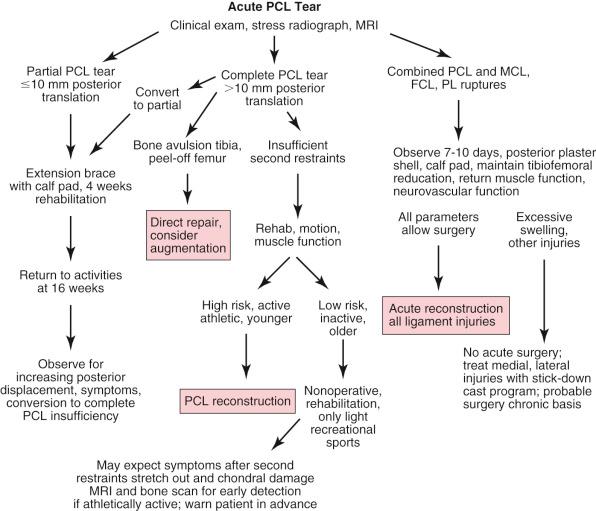
There are cases of complete isolated mid-substance PCL ruptures (>10 mm of increased posterior tibial displacement) in which the patient is seen late after the injury and the previously discussed program cannot be instituted. In athletes and patients involved in strenuous occupations, one treatment approach is PCL graft reconstruction before the secondary restraints stretch out with subsequent reinjury. We believe that PCL reconstructive procedures have advanced to the point where more predictable results can be expected to restore sufficient PCL function to prevent gross posterior tibial subluxation. Studies have demonstrated, at least in the short term, that the majority of patients with acute PCL ruptures treated with reconstruction are able to return to various levels of sports activities. Additional factors to be weighed in the decision to perform early surgery on a complete isolated PCL rupture include athletic goals, body weight, medial meniscus damage, tibiofemoral joint damage, patellofemoral joint damage, and varus malalignment. These factors add to the effects of the residual posterior subluxation in increasing knee joint loads and subsequent joint deterioration. Future long-term clinical studies will confirm the importance of these factors in the operative decision of early restoration of PCL function in active younger individuals who subject their knee to high forces in sports or work activities. Sedentary patients with a complete PCL rupture and 10 mm of posterior translation (90 degrees of flexion) are not considered surgical candidates; however, they are followed as previously described.
Patients with a PCL disruption and other ligament injuries have an obvious posterior tibial dropback without a firm endpoint on posterior drawer testing (≥10 mm of posterior tibial subluxation). In almost all of these knees, some increase in medial or lateral joint opening or external tibial rotation can be detected, although the findings may be subtle. There may be physiologic laxity of other ligament structures without a true injury that allows for the gross posterior tibial subluxation (see Chapter 3 ).
In knees that present with acute disruption of the PCL and medial or posterolateral structures, reconstruction should be delayed until the neurovascular status and other injuries are evaluated and the decision reached that major knee ligament surgery can be safely performed. In knees that have associated posterolateral ruptures, acute anatomic repair is planned if possible within 14 days before scarring occurs and the ability to anatomically restore these structures is lost (see Chapter 17 ). A similar situation exists for the medial ligament structures; however, these tissues are easier to reconstruct later if surgery cannot be performed in the ideal time period for anatomic repair.
There may exist a displaced meniscus tear requiring early treatment. As a word of caution, a displaced meniscus should be reduced into the tibiofemoral joint by 3 weeks to prevent meniscus shortening and scarring that compromise a future repair and result in loss of meniscus function. Even in knees that have marked soft tissue swelling and edema in which major ligament reconstruction is contraindicated, a meniscus repair using all-inside techniques can be performed to reduce the meniscus to a normal tibiofemoral position. The mistake is to wait until 6 weeks or later, expecting that the meniscus repair can be performed at that time.
Too frequently, major ligament surgery in dislocated knees performed under acute conditions results in joint arthrofibrosis, compromising the result. Patients should be carefully selected for acute multiligament repairs, realizing that there are proven techniques for reconstruction of the ruptured ligaments performed later under more ideal conditions. When surgery is performed on acute combined PCL and posterolateral ruptures, the procedure includes the use of appropriate grafts to restore lateral stability and allow an early protected range of knee motion program (see Chapter 17 ).
The majority of acute knee dislocations should be treated in a staged approach by first treating the acute injury and then determining if a ligament reconstruction should be performed either within the 10- to 14-day envelope or delayed. When early surgery is not advisable, the knee is protected for the first 4 weeks to prevent posterior tibial subluxation, as already described for acute isolated PCL ruptures. AP and lateral radiographs are obtained with the knee placed in a posterior plaster shell and a soft bolster positioned beneath the calf to prevent posterior tibial subluxation. The capsular tissues heal in 7 to 10 days to provide enough stability to prevent recurrence of dislocation.
If a nonoperative approach is selected with associated MCL and posteromedial capsular disruptions, the same program is followed with the lower limb placed in a cylinder cast to allow “stick-down” of the medial soft tissues. Plaster immobilization is required because a soft hinged brace, even if maintained at 0 degrees of extension, does not provide sufficient protection to maintain medial joint line closure to allow the disrupted medial tissues to heal. At 7 to 10 days, the cylinder cast is split into an anterior and posterior shell and the therapist assists the patient with range of motion from 0 to 90 degrees in a figure-four position with the hip joint externally rotated to protect the healing medial tissues. This program of “aggressive” nonoperative treatment of associated medial ligament injuries is described in further detail in Chapter 20 .
In multiligament knee injuries, a deep venous thrombosis (DVT) program is instituted that involves assessment of risk factors such as family or personal history of DVT and use of estrogen products in women. A lower extremity ultrasound is obtained before surgery. Postoperative care includes initial use of compressive calf devices, ankle pumps, and early mobilization and ambulation to avoid unnecessary bed rest. In the absence of specific risk factors requiring chemical prophylaxis, we routinely use one aspirin (325 mg) twice daily and pay close attention for signs of a DVT.
The algorithm for the treatment of chronic PCL ruptures is shown in Figure 16-17 . The symptoms and clinical examination determine the functional limitations, particularly the component of symptoms because of medial tibiofemoral or patellofemoral arthritis because these problems are likely to persist after surgical stabilization. Knees with chronic PCL ruptures are arbitrarily divided into three categories: those with varus osseous malalignment (and rarely, valgus malalignment) in which an osteotomy must be considered, those with an isolated PCL rupture in which reconstruction may or may not be necessary, and those with significant combined ligament injuries that require reconstruction.
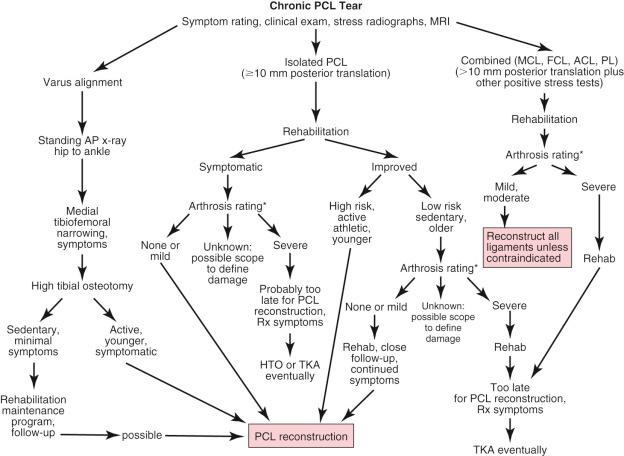
Patients are entered into a formal rehabilitation program to correct muscular weakness and gait-related problems (hyperextension) when required. The amount of joint arthritis must be determined with accuracy. Radiographs (merchant, standing PA at 45 degrees) and MRI articular cartilage fast spin-echo sequences provide valuable information.
In knees with no or only mild articular cartilage damage, an assessment of the patient's goals and athletic desires may indicate the need to proceed with PCL reconstruction. Combined ligament ruptures that produce complex instability patterns require careful clinical assessment to detect all of the joint subluxations and ligament deficiencies present.
Knees that have advanced arthritis are not expected to benefit from ligament reconstruction. In these knees, areas of exposed bone are frequently encountered in the medial tibiofemoral compartment, along with diffuse cartilage fragmentation in the patellofemoral joint. In these individuals, even mildly strenuous exercises aggravate the joint arthritis symptoms and cannot be performed. The patient's initial experience with rehabilitation, and the inability to perform the required exercises, provides important information regarding the amount of joint arthritis present and joint symptoms that are likely permanent.
If a nonoperative approach is elected, the clinician should warn the patient that the return to athletic activities may carry an uncertain prognosis, and that although sports may be resumed in the short term, some form of joint arthritis will eventually ensue. It is therefore important to follow the patient at regular intervals. A bone scan may be used to provide some indication of abnormal blood flow dynamics; however, it is our experience that the onset of pain and swelling usually indicates more advanced joint damage and a poor prognosis after PCL reconstruction. An MRI with fast spin-echo sequences provides a baseline for repeated studies at 1- to 2-year intervals. The nonoperative treatment protocol for chronic PCL injuries involves educating the patient to avoid activities such as lunges and other high knee flexion activities that increase posterior tibial subluxation.
Patient and staff identification of surgical procedure, “time-out,” operative site signed by surgeon.
Repeat all knee ligament subluxation tests under anesthesia.
Rate all articular cartilage surfaces
Normal.
Grade 1, softening.
Grade 2 A, fissuring & fragmentation < ![]() depth of the articular surface.
depth of the articular surface.
Grade 2 B, fissuring & fragmentation > ![]() depth of the articular surface.
depth of the articular surface.
Grade 3, subchondral bone exposed.
Medial and lateral gap test at arthroscopy
Knee 30 degrees of flexion.
Measure millimeters tibiofemoral compartment opening with calibrated nerve hook.
The patient is instructed to use a chlorhexidine scrub of the body with emphasis on the operative limb (“toes to groin”) 3 days before surgery and the evening before and the morning of surgery. Lower extremity hair is removed by clippers, not a shaver. Antibiotic infusion is begun 1 hour before surgery. A nonsteroidal antiinflammatory drug (NSAID) is given to the patient with a sip of water upon arising the morning of surgery (which is continued until the fifth postoperative day unless there are specific contraindications to the medicine). The use of an NSAID and a postoperative firm double-cotton, double-Ace compression dressing for 72 hours (cotton, Ace, cotton, Ace-layered dressing) has proven very effective in diminishing soft tissue swelling and is used in all knee surgery cases. In select knees that demonstrate soft tissue swelling before or after surgery, the judicious use of an intravenous corticosteroid for two to three days may be necessary. This is especially relevant in larger muscular patients in whom postoperative swelling of the entire lower extremity may occur. In complex multiligament surgery, the antibiotic is repeated at 4 hours and continued for 24 hours. A urinary indwelling catheter is not used unless there are specific indications. The patients' urinary output and total fluids are carefully monitored during the procedure and in the recovery room.
The knee skin area is initialized by the surgeon before entering the operating room, with a nurse observing the procedure. The identification process is repeated with all operative personnel with a “time out” before surgery to verify the patient's name and birth date, knee undergoing surgery, procedure, allergies, antibiotic infusion, and special precautions that apply. All personnel provide verbal agreement.
All knee ligament subluxation tests are performed after the induction of anesthesia in both the injured and contralateral limbs. The amount of increased anterior tibial translation, posterior tibial translation, lateral and medial joint opening, and external tibial rotation is documented. In acute knee injuries, arthroscopic pressure is maintained at a low setting with adequate outflow at all times to prevent fluid extravasation, which is carefully monitored during the procedures that follow. A thorough arthroscopic examination should be conducted, documenting articular cartilage surface abnormalities and the condition of the menisci.
The medial and lateral tibiofemoral gap test is done during the arthroscopic examination (see Chapter 17 ). The knee is flexed 30 degrees and a varus and valgus load of approximately 89 N applied. A calibrated nerve hook is used to measure the amount of lateral and medial tibiofemoral compartment opening. Twelve mm or more of joint opening at the periphery of the compartment indicates the need for a combined lateral or medial ligament reconstructive procedure to protect and unload the PCL reconstruction. The presence of 10 mm of opening is a gray zone that, in some instances, may require concurrent surgery. The goal is to restore the function of all ligament structures to normal or nearly normal and not leave a knee with a residual ligament insufficiency. This also applies to the ACL, which is reconstructed at the time of PCL surgery when deficient.
Appropriate arthroscopic procedures are performed as indicated including meniscus repairs or partial excision, debridement, and articular cartilage procedures.
Become a Clinical Tree membership for Full access and enjoy Unlimited articles
If you are a member. Log in here